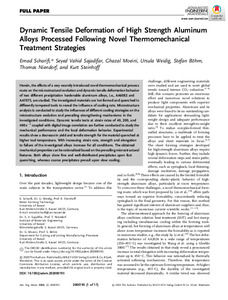Datum
2020-05-14Autor
Scharifi, EmadSajadifar, Seyed VahidMoeini, GhazalWeidig, UrsulaBöhm, StefanNiendorf, ThomasSteinhoff, KurtMetadata
Zur Langanzeige
Aufsatz
Artikel (Publikationen im Open Access gefördert durch die UB)

Dynamic Tensile Deformation of High Strength Aluminum Alloys Processed Following Novel Thermomechanical Treatment Strategies
Zusammenfassung
Herein, the effects of a very recently introduced novel thermomechanical process route on the microstructural evolution and dynamic tensile deformation behavior of two different precipitation hardenable aluminum alloys, i.e., AA6082 and AA7075, are studied. The investigated materials are hot formed and quenched in differently tempered tools to reveal the influence of cooling rate. Microstructure analysis is conducted to study the influences of different cooling strategies on the microstructure evolution and prevailing strengthening mechanisms in the investigated conditions. Dynamic tensile tests at strain rates of 40, 200, and 400 s−1 coupled with digital image correlation are further conducted to study the mechanical performance and the local deformation behavior. Experimental results show a decrease in yield and tensile strength for the material quenched at higher tool temperature. With increasing strain rate, strength and elongation to failure of the investigated alloys increase for all conditions. The obtained mechanical properties can be rationalized based on the prevailing microstructural features. Both alloys show fine and well‐distributed precipitates upon fast quenching, whereas coarse precipitates prevail upon slow cooling.
Zitierform
In: Advanced Engineering Materials Volume 22 / Issue 8 (2020-05-14) , S. 2000193 ; EISSN 1527-2648Förderhinweis
Gefördert im Rahmen des Projekts DEALSammlung(en)
Publikationen (Fachgebiet Metallische Werkstoffe)Artikel (Publikationen im Open Access gefördert durch die UB)
Zitieren
@article{doi:10.17170/kobra-202008281680,
author={Scharifi, Emad and Sajadifar, Seyed Vahid and Moeini, Ghazal and Weidig, Ursula and Böhm, Stefan and Niendorf, Thomas and Steinhoff, Kurt},
title={Dynamic Tensile Deformation of High Strength Aluminum Alloys Processed Following Novel Thermomechanical Treatment Strategies},
journal={Advanced Engineering Materials},
year={2020}
}
0500 Oax
0501 Text $btxt$2rdacontent
0502 Computermedien $bc$2rdacarrier
1100 2020$n2020
1500 1/eng
2050 ##0##http://hdl.handle.net/123456789/11782
3000 Scharifi, Emad
3010 Sajadifar, Seyed Vahid
3010 Moeini, Ghazal
3010 Weidig, Ursula
3010 Böhm, Stefan
3010 Niendorf, Thomas
3010 Steinhoff, Kurt
4000 Dynamic Tensile Deformation of High Strength Aluminum Alloys Processed Following Novel Thermomechanical Treatment Strategies / Scharifi, Emad
4030
4060 Online-Ressource
4085 ##0##=u http://nbn-resolving.de/http://hdl.handle.net/123456789/11782=x R
4204 \$dAufsatz
4170
5550 {{Aluminium}}
5550 {{Aluminiumlegierung}}
5550 {{Thermomechanische Eigenschaft}}
5550 {{Mikrostruktur}}
7136 ##0##http://hdl.handle.net/123456789/11782
<resource xsi:schemaLocation="http://datacite.org/schema/kernel-2.2 http://schema.datacite.org/meta/kernel-2.2/metadata.xsd"> 2020-09-04T11:11:15Z 2020-09-04T11:11:15Z 2020-05-14 doi:10.17170/kobra-202008281680 http://hdl.handle.net/123456789/11782 Gefördert im Rahmen des Projekts DEAL eng Namensnennung 4.0 International http://creativecommons.org/licenses/by/4.0/ dynamic tensile deformation high-strength aluminum alloys hot forming microstructures thermomechanical processing 600 Dynamic Tensile Deformation of High Strength Aluminum Alloys Processed Following Novel Thermomechanical Treatment Strategies Aufsatz Herein, the effects of a very recently introduced novel thermomechanical process route on the microstructural evolution and dynamic tensile deformation behavior of two different precipitation hardenable aluminum alloys, i.e., AA6082 and AA7075, are studied. The investigated materials are hot formed and quenched in differently tempered tools to reveal the influence of cooling rate. Microstructure analysis is conducted to study the influences of different cooling strategies on the microstructure evolution and prevailing strengthening mechanisms in the investigated conditions. Dynamic tensile tests at strain rates of 40, 200, and 400 s−1 coupled with digital image correlation are further conducted to study the mechanical performance and the local deformation behavior. Experimental results show a decrease in yield and tensile strength for the material quenched at higher tool temperature. With increasing strain rate, strength and elongation to failure of the investigated alloys increase for all conditions. The obtained mechanical properties can be rationalized based on the prevailing microstructural features. Both alloys show fine and well‐distributed precipitates upon fast quenching, whereas coarse precipitates prevail upon slow cooling. open access Scharifi, Emad Sajadifar, Seyed Vahid Moeini, Ghazal Weidig, Ursula Böhm, Stefan Niendorf, Thomas Steinhoff, Kurt doi:10.1002/adem.202000193 Aluminium Aluminiumlegierung Thermomechanische Eigenschaft Mikrostruktur publishedVersion EISSN 1527-2648 Issue 8 Advanced Engineering Materials 2000193 Volume 22 false </resource>
Die folgenden Lizenzbestimmungen sind mit dieser Ressource verbunden:


